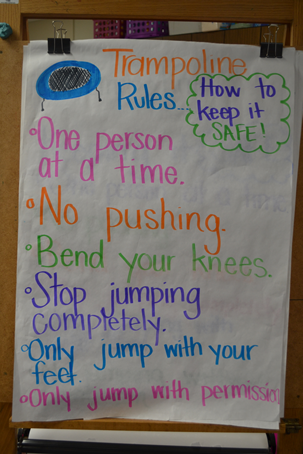 As a physical education teacher, I use fitness trampolines in my program to teach about health-related fitness and intensity level training. My school’s sensory room has a fitness trampoline to help meet the needs of special education students. I find fitness trampolines to be a fun, safe, and effective tool for schools to increase classroom activity. For high-quality fitness trampolines, I recommend Gopher’s UltraFit EverBound Rebounder. Moving Minds and Gopher are part of the Gopher Sport family of brands, which means all products are backed by an Unconditional 100% Satisfaction Guarantee.
As a physical education teacher, I use fitness trampolines in my program to teach about health-related fitness and intensity level training. My school’s sensory room has a fitness trampoline to help meet the needs of special education students. I find fitness trampolines to be a fun, safe, and effective tool for schools to increase classroom activity. For high-quality fitness trampolines, I recommend Gopher’s UltraFit EverBound Rebounder. Moving Minds and Gopher are part of the Gopher Sport family of brands, which means all products are backed by an Unconditional 100% Satisfaction Guarantee.
As a parent of a Kindergartener, I desire that my child’s classroom be one that supports and recognizes the developmental nature of young people and their need to move. I am very thankful my child’s teacher understands this and does an amazing job integrating movement throughout the day for her young learners.
This year, she integrated a fitness trampoline, and it was an immediate hit with both the students and teacher. She uses it for teaching academic content and as an activity break or brain boost for students. It has been a positive addition to the classroom. Here are some useful applications and tips for integrating a fitness trampoline into any classroom I learned during an interview with my child’s teacher about their fitness trampoline.
The teacher shared that, from an academic perspective, she likes to incorporate movement into all lessons and subjects. “Movement and motion create memories, and this trampoline has really increased learning across the curriculum. It is also great for inside recess. On rainy days, students can use it during recess time to get the wiggles out.”
“The kids love jumping on the trampoline and love cheering on their friends as well. They like jumping different ways and playing different learning games. They also love when the special person of the week (or one being randomly chosen) gets to jump on the trampoline during brain breaks or dance songs.” One of her favorite ways to use the trampoline was for student celebrations. “We turn the lights off, the music up, and have a jumping party to celebrate student success. Something we like to celebrate is counting all the way to 100 by ones and tens or mastering all of our sight words.”
Academic Content & Movement Integration Ideas:
One trampoline can be shared by the whole group and used in a variety of ways throughout the day to increase classroom activity.
- Math: counting by ones and tens and interactive adding and subtracting challenges where you give an equation: “5 and 3 more” and the student has to jump 8 times.
- Spelling: Learn to spell sight words by saying each letter as you jump.
- Syllables: Learn to feel how to count each syllable by jumping.
- Activity Break: Take turns using the trampoline for activity breaks.
- Inside Recess: Draw names randomly and set a timer for 3 minutes per turn.
- Stations: Use as a station. Reinforce learning how to take turns and use a timer.
- Sensory Break: A great sensory break for specific students. Use a timer.
- Peer Feedback: Have students coach each other and cheer each other on.
- Follow the Leader: Students mirror the jumps the trampoline student is doing.
- Favorite Moves: Jumping jacks, side to side, front to back, twist, run, one-foot hop.
- Daily Use: Have a goal to allow each student to get at least one turn each day.
- Student Celebrations: Celebrate learning. Using a trampoline puts a smile on faces.
Trampoline Size & Sturdiness:
My child’s teacher loved the size of the trampoline. “It is the perfect size for my little learners. It is big enough for them to bounce safely. The size also allows for the students to be able to not only jump up and down safely but side-to-side as well. I like the springs being covered up by the blue padding. The trampoline is very sturdy. It is also lightweight and can be moved quickly and easily.”
Classroom Trampoline Expectations:

The fitness trampoline is a huge hit with students of every grade level. Like all new things, be sure to develop expectations for use and emphasize safety.
Teach students how to properly jump on it, how to start and stop properly, and how to take turns and use a timer.
Stress to students that a fitness trampoline is not an outdoor trampoline where you jump high. Here, you are pushing down into the trampoline for resistance and challenge.
Teach students to keep a knee bend and hip hinge (athletic position) so as not to land straight-legged to reduce injury and help maintain self-control. Always come to a controlled stop before getting off the trampoline. Never jump off.
It is important to talk about safety each day. During morning meeting time, review safety expectations of the trampoline and how to properly use to help set kids up for success.
Establish Expectations with Students:
To set up expectations and rules, the teacher had a safety meeting when the trampoline first arrived. The students, as a whole, decided on rules. The teacher talked about each rule and then had students practice each rule. At the beginning of each lesson where the trampoline will be used, they do a quick refresher on the rules. One rule the teacher felt most strongly about is only use the trampoline with permission. She had the trampoline out and ready for use at all times. If a student jumped without permission (or even walked across the trampoline while moving throughout the classroom), it was put away for the day. This only happened one time. Getting the students invested in the safety of the trampoline as well being able to use it each day was important for overall success.
A big thank you to my child’s teacher for sharing this information! I would encourage all to add a fitness trampoline to their teaching toolbox to promote active learning and classroom activity.
Jessica Shawley is a middle school physical education teacher. She is a SHAPE America National Middle School Physical Education Teacher of the Year and is National Board (NBPTS) certified as a Physical Education Specialist. Jessica received her Master’s Degree in Curriculum and Instruction from the University of Idaho and undergraduate degree in K-12 Health & Fitness, Math & Leadership Studies from Whitworth University.





Jessica you are right. Trampoline is an effective tool for schools to increase classroom activity and for kids to handle their stress and anxiety effectively. I personally think every school need to be aware about this.